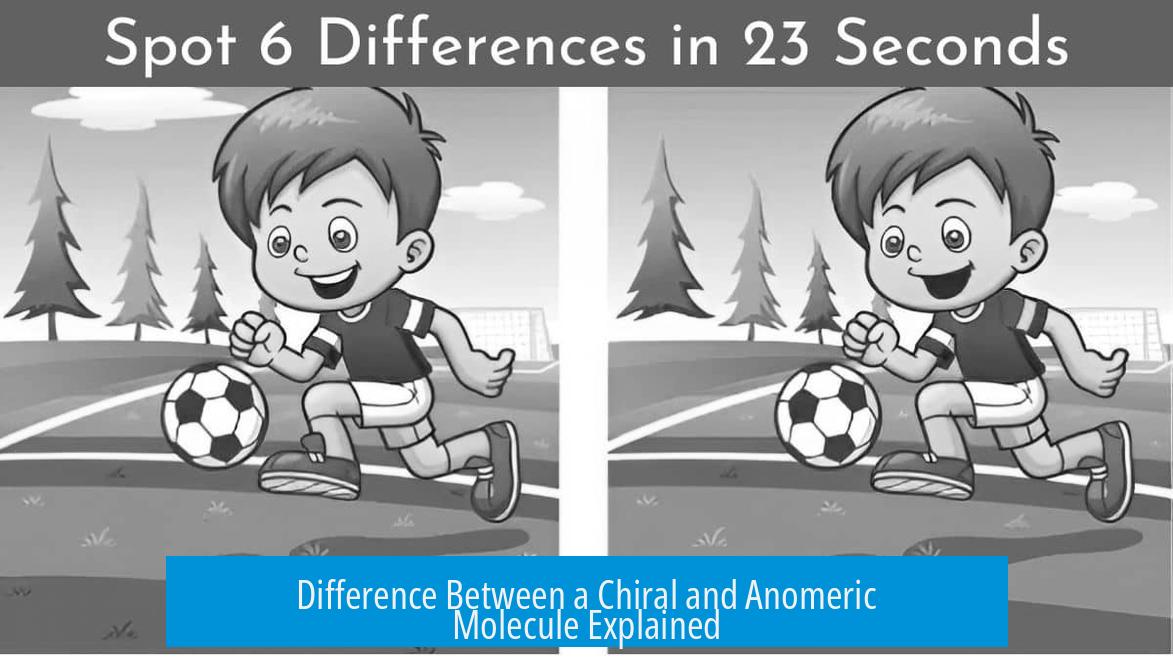Difference between a Chiral and Anomeric Molecule
A chiral molecule is any molecule with one or more chiral centers, whereas an anomeric molecule refers specifically to a cyclic sugar epimer differing at the anomeric carbon (C-1) only. This fundamental distinction lies in their definitions, stereochemical centers, and chemical context.
What Is a Chiral Molecule?
A chiral molecule contains at least one chiral center—an atom, typically carbon, bonded to four different groups. This asymmetry leads to non-superimposable mirror images called enantiomers. Each chiral center must invert to form the enantiomer of a molecule. For example, a molecule with three chiral centers configured as [S,S,S] has an enantiomer with configurations [R,R,R].
If only one chiral center differs, the molecules are not enantiomers but epimers. For instance, a [S,S,R] molecule is an epimer of [S,S,S], differing at only one stereocenter.
What Is an Anomeric Molecule?
An anomer is a specific term describing a type of epimer exclusively in cyclic sugars. It refers to the stereochemical difference at the anomeric carbon—the hemiacetal or acetal carbon, which is typically at position C-1 in monosaccharides. Unlike general chiral centers, this difference is confined to one specific carbon in the sugar ring.
Anomers are a subclass of diastereomers and are unique to carbohydrates. The key feature is that α- and β-anomers differ only at the anomeric carbon’s configuration. For example, glucose in cyclic form exists as α- or β-glucose, which are anomers.
Key Differences Between Chiral and Anomeric Molecules
| Aspect | Chiral Molecule | Anomeric Molecule |
|---|---|---|
| Definition | Any molecule with one or more chiral centers | Specific epimer of a cyclic sugar at the anomeric carbon |
| Stereochemical Difference | One or multiple chiral centers can differ | Only at the anomeric carbon (C-1) |
| Use of Term | General use for stereogenic centers across molecules | Exclusive to carbohydrates (cyclic sugars) |
| Relation to Other Stereoisomers | Can be enantiomers or epimers depending on how many centers differ | Always an epimer that differs at the anomeric carbon |
Additional Unique Feature of Anomers
Anomers can interconvert in aqueous solutions through mutarotation, establishing an equilibrium between α- and β-forms. This dynamic process does not typically occur for general chiral molecules. This equilibrium explains why anomers are special compared to other chiral molecules, which often exist as fixed stereoisomers without spontaneous interconversion.
Key Takeaways
- Chiral molecules have one or more chiral centers; anomers are specific epimers at the anomeric carbon of cyclic sugars.
- Enantiomers require inversion at all chiral centers; anomers differ only at C-1.
- Anomer is a term exclusive to carbohydrate chemistry.
- Anomers can interconvert in solution (mutarotation); general chiral molecules usually cannot.
What defines a chiral molecule compared to an anomeric molecule?
A chiral molecule has one or more chiral centers, while an anomeric molecule is a special epimer found only in cyclic sugars. The difference for anomers is at the anomeric carbon, typically the C-1 position.
Can an anomeric molecule be considered an enantiomer?
No. Anomers are a type of diastereomer and differ only at the anomeric carbon. Enantiomers differ at all chiral centers. Anomers are specific epimers within carbohydrates.
Why are anomers unique among chiral molecules?
Anomers can interconvert in water, forming an equilibrium between different forms. Other chiral molecules usually do not readily interconvert in solution like anomers do.
What is the role of the anomeric carbon in anomers?
The anomeric carbon is the hemiacetal or acetal carbon in cyclic sugars where the stereochemical difference occurs. This defines the unique nature of anomers as epimers.
Are epimers and anomers the same thing?
Not exactly. Anomers are a specific type of epimer in cyclic sugars with differences only at the anomeric carbon. Epimers can be any two stereoisomers differing at one chiral center in any molecule.





Leave a Comment